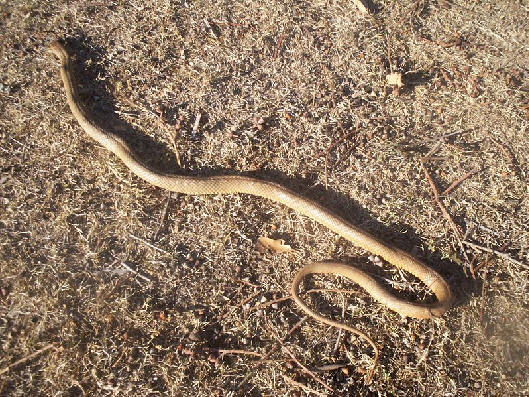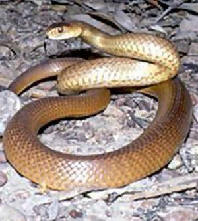Eastern Brown Snake
|
The Eastern Brown Snake, often referred to as the Common Brown Snake, is a snake native to Australia, and there is a subspecies in parts of New Guinea. It is one of the world's deadliest land snakes. This, combined with a native habitat which includes the well-populated East coast of Australia, has resulted in fatalities. It occupies a varied range of habitats from wet to dry forests (Eucalypt forests) and heaths of coastal ranges, through to savannah woodlands, inner grasslands and arid scrublands. It is not found in rainforests or other wet areas. Due to their mainly rodent diet, they can often be found near houses and farms. Such areas also normally provide shelter in the form of rubbish and other cover. Such habits regularly bring the species in contact with humans and its bad temper and toxic venom may lead to potentially dangerous conflicts. The Eastern Brown snake is diurnal (meaning it is active during the day). When highly agitated, they hold their necks high, appearing in an upright S-shape. But despite their fearsome reputation, brown snakes are reluctant to bite and react only to movement; standing still when in close proximity to one will result in it ignoring you.
Being an opportunistic feeder, the Eastern Brown will consume almost any vertebrate animal, including frogs, lizards, snakes, birds and rodents. Their preferred diet is mice and rats.
Adult Eastern Brown Snakes are highly variable in colour. Whilst usually a uniform shade of brown, they can have various patternings including speckles and bands, and range from a very pale fawn colour through to black, including orange, silver, yellow and grey. Juveniles have a black head, with a lighter band behind, a black nape, and numerous red-brown spots on the belly. Occasionally they have dark cross-bands. Most specimens reach around 1.5 metres in length, with some exceeding two metres.
The Eastern Brown Snake is the second most venomous land snake in the world after the Inland Taipan. Although Eastern Browns will seek to avoid confrontation, their venom is very toxic, and can be fatal; even juveniles have caused human fatalities. The venom contains both neurotoxins and blood coagulants. Brown snake envenomations are characterized by disseminated intravascular coagulation (DIC), paralysis, and cardiovascular depression. Other, less common, manifestations are conduction defects, thrombocytopenia, renal failure, and intracranial haematomas. Since the development of antivenin and the use of compression bandages, fatalities from brown snake bites have become rare. However, in spite of prompt medical care and antivenin administration, the potency of the venom has produced fatalities. Early deaths (within hours) are thought to result from the venom's cardiotoxic effect as well as anaphylaxis to the venom. Delayed deaths appear to result from secondary complications, such as intracranial haemorrhage, from the venom's hemotoxins. |

